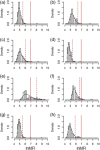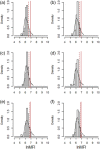Serological evidence of a pararubulavirus and a betacoronavirus in the geographically isolated Christmas Island flying-fox (Pteropus natalis)
- PMID: 35491954
- PMCID: PMC9529767
- DOI: 10.1111/tbed.14579
Serological evidence of a pararubulavirus and a betacoronavirus in the geographically isolated Christmas Island flying-fox (Pteropus natalis)
Abstract
Due to their geographical isolation and small populations, insular bats may not be able to maintain acute immunizing viruses that rely on a large population for viral maintenance. Instead, endemic transmission may rely on viruses establishing persistent infections within hosts or inducing only short-lived neutralizing immunity. Therefore, studies on insular populations are valuable for developing broader understanding of viral maintenance in bats. The Christmas Island flying-fox (CIFF; Pteropus natalis) is endemic on Christmas Island, a remote Australian territory, and is an ideal model species to understand viral maintenance in small, geographically isolated bat populations. Serum or plasma (n = 190), oral swabs (n = 199), faeces (n = 31), urine (n = 32) and urine swabs (n = 25) were collected from 228 CIFFs. Samples were tested using multiplex serological and molecular assays, and attempts at virus isolation to determine the presence of paramyxoviruses, betacoronaviruses and Australian bat lyssavirus. Analysis of serological data provides evidence that the species is maintaining a pararubulavirus and a betacoronavirus. There was little serological evidence supporting the presence of active circulation of the other viruses assessed in the present study. No viral nucleic acid was detected and no viruses were isolated. Age-seropositivity results support the hypothesis that geographically isolated bat populations can maintain some paramyxoviruses and coronaviruses. Further studies are required to elucidate infection dynamics and characterize viruses in the CIFF. Lastly, apparent absence of some pathogens could have implications for the conservation of the CIFF if a novel disease were introduced into the population through human carriage or an invasive species. Adopting increased biosecurity protocols for ships porting on Christmas Island and for researchers and bat carers working with flying-foxes are recommended to decrease the risk of pathogen introduction and contribute to the health and conservation of the species.
Keywords: Pteropodidae; bat; betacoronavirus; insular populations; pararubulavirus; viral maintenance.
© 2022 The Authors. Transboundary and Emerging Diseases published by Wiley-VCH GmbH.
Conflict of interest statement
There are no conflicts of interest.
Figures



Similar articles
-
Limited diversity of bat-associated RNA viruses in endangered and geographically isolated Christmas Island flying foxes.One Health. 2025 May 3;20:101060. doi: 10.1016/j.onehlt.2025.101060. eCollection 2025 Jun. One Health. 2025. PMID: 40475261 Free PMC article.
-
Evidence of chronic cadmium exposure identified in the critically endangered Christmas Island flying-fox (Pteropus natalis).Sci Total Environ. 2021 Apr 20;766:144374. doi: 10.1016/j.scitotenv.2020.144374. Epub 2020 Dec 26. Sci Total Environ. 2021. PMID: 33421794
-
Seroprevalence of three paramyxoviruses; Hendra virus, Tioman virus, Cedar virus and a rhabdovirus, Australian bat lyssavirus, in a range expanding fruit bat, the Grey-headed flying fox (Pteropus poliocephalus).PLoS One. 2020 May 6;15(5):e0232339. doi: 10.1371/journal.pone.0232339. eCollection 2020. PLoS One. 2020. PMID: 32374743 Free PMC article.
-
Managing emerging diseases borne by fruit bats (flying foxes), with particular reference to henipaviruses and Australian bat lyssavirus.J Appl Microbiol. 2003;94 Suppl:59S-69S. doi: 10.1046/j.1365-2672.94.s1.7.x. J Appl Microbiol. 2003. PMID: 12675937 Review.
-
Emerging tropical diseases in Australia. Part 3. Australian bat lyssavirus.Ann Trop Med Parasitol. 2010 Dec;104(8):613-21. doi: 10.1179/136485910X12851868779948. Ann Trop Med Parasitol. 2010. PMID: 21144181 Review.
Cited by
-
Limited diversity of bat-associated RNA viruses in endangered and geographically isolated Christmas Island flying foxes.One Health. 2025 May 3;20:101060. doi: 10.1016/j.onehlt.2025.101060. eCollection 2025 Jun. One Health. 2025. PMID: 40475261 Free PMC article.
-
Rhinolophus sinicus virome revealed multiple novel mosquito-borne zoonotic viruses.Front Cell Infect Microbiol. 2022 Oct 11;12:960507. doi: 10.3389/fcimb.2022.960507. eCollection 2022. Front Cell Infect Microbiol. 2022. PMID: 36304937 Free PMC article.
-
The Batalogue: an overview of betacoronaviruses with future pandemic potential.FEMS Microbiol Rev. 2025 Jan 14;49:fuaf023. doi: 10.1093/femsre/fuaf023. FEMS Microbiol Rev. 2025. PMID: 40434829 Free PMC article. Review.
References
-
- Boardman, W. S. J. , Baker, M. L. , Boyd, V. , Crameri, G. , Peck, G. R. , Reardon, T. , Smith, I. G. , Caraguel, C. G. B. , & Prowse, T. A. A. (2020a). Serological evidence of exposure to a coronavirus antigenically related to severe acute respiratory syndrome virus (SARS‐CoV‐1) in the Grey‐headed flying fox (Pteropus poliocephalus). Transboundary and Emerging Diseases, 68(4), 2628–2632. 10.1111/tbed.13908 - DOI - PubMed
-
- Boardman, W. S. J. , Baker, M. L. , Boyd, V. , Crameri, G. , Peck, G. R. , Reardon, T. , Smith, I. G. , Caraguel, C. G. B. , & Prowse, T. A. A. (2020b). Seroprevalence of three paramyxoviruses; Hendra virus, Tioman virus, Cedar virus and a rhabdovirus, Australian bat lyssavirus, in a range expanding fruit bat, the Grey‐headed flying fox (Pteropus poliocephalus). PLoS One, 15(5), e0232339. 10.1371/journal.pone.0232339 - DOI - PMC - PubMed
-
- Bossart, K. N. , McEachern, J. A. , Hickey, A. C. , Choudhry, V. , Dimitrov, D. S. , Eaton, B. T. , & Wang, L.‐F. (2007). Neutralization assays for differential henipavirus serology using Bio‐Plex Protein Array Systems. Journal of Virological Methods, 142(1‐2), 29–40. 10.1016/j.jviromet.2007.01.003 - DOI - PubMed
MeSH terms
Substances
Grants and funding
LinkOut - more resources
Full Text Sources

